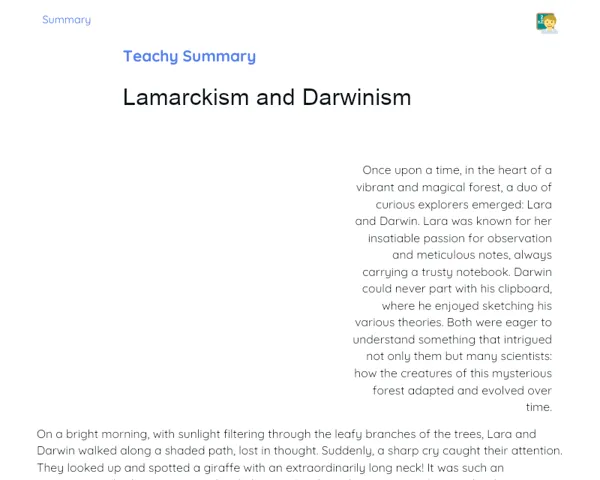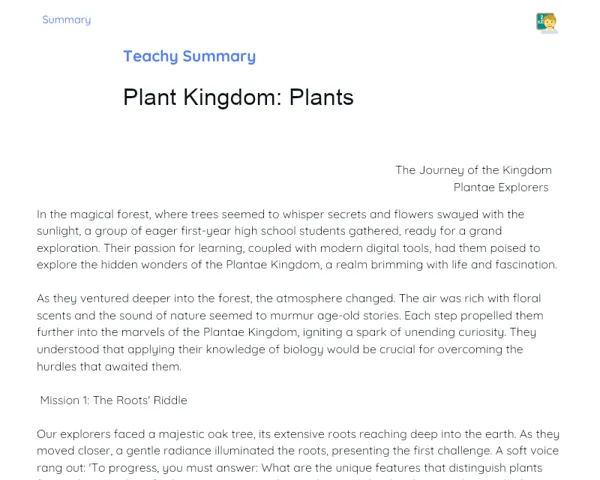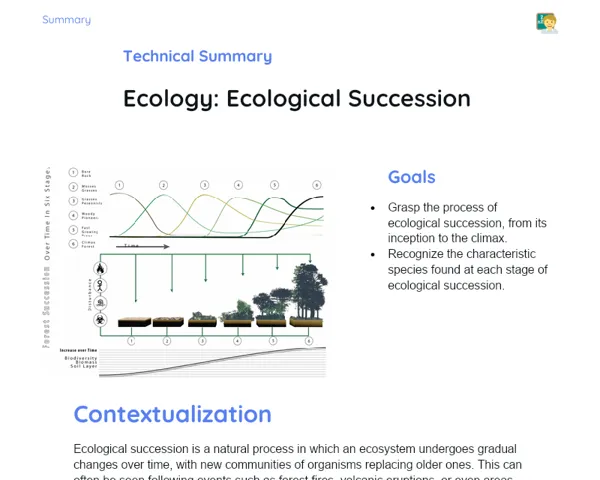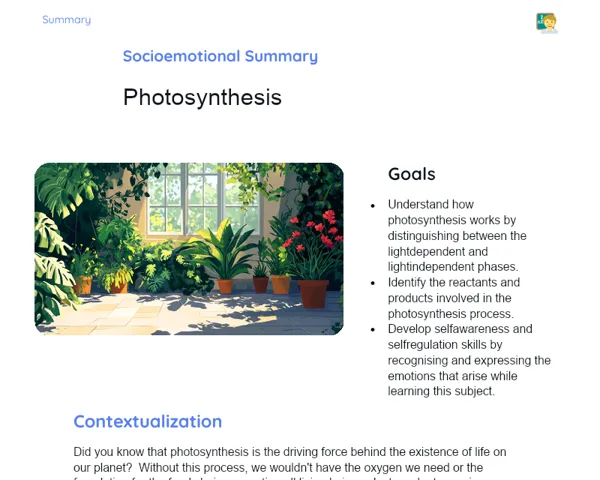Summary Tradisional | Cell Division
Contextualization
Cell division is a vital process for sustaining life, allowing organisms to grow, develop, heal damaged tissues, and reproduce. For unicellular organisms, cell division serves as the only way to reproduce, while in multicellular organisms, it's crucial for growth and tissue regeneration. There are two primary types of cell division: mitosis, which results in two genetically identical daughter cells, and meiosis, which generates cells with half the number of chromosomes, essential for sexual reproduction.
The cell cycle, comprising interphase and the mitotic phase, describes the stages a cell goes through from its formation to its eventual division. Interphase is the preparatory phase where the cell grows, duplicates its DNA, and gets ready for division. The mitotic phase is when the actual division happens, resulting in new cells. Grasping these processes and their phases is key to understanding how organisms sustain their biological functions, grow, regenerate, and reproduce. Throughout this lesson, we’ll delve into the phases of mitosis and meiosis, their characteristics, and their biological significance.
To Remember!
Cell Cycle
The cell cycle is the sequence through which a cell progresses from its formation to splitting into two daughter cells. It's divided into two major phases: interphase and the mitotic phase. Interphase is further broken down into three stages: G1, S, and G2. During the G1 stage, the cell grows and carries out regular metabolic functions. DNA replication takes place in the S stage, and during G2, the cell keeps growing and gears up for mitosis.
The mitotic phase involves both mitosis and cytokinesis. Mitosis is the mechanism where replicated chromosomes are sorted into two identical nuclei, and cytokinesis is the cytoplasmic division that results in two daughter cells. The cell cycle is essential for maintaining life as it supports growth, tissue healing, and the reproduction of organisms.
The regulation of the cell cycle is managed by a series of proteins and complexes that ensure that each step is completed properly. If errors are detected, control mechanisms may pause the cycle and rectify them, thus preventing potential damage that could lead to conditions like cancer.
-
Interphase: G1, S, and G2.
-
Mitotic phase: mitosis and cytokinesis.
-
Regulation and control of the cell cycle.
Mitosis
Mitosis is the cell division process resulting in two genetically identical daughter cells. It is crucial for growth and tissue repair in multicellular organisms. Mitosis comprises five main phases: prophase, metaphase, anaphase, telophase, and cytokinesis.
In prophase, chromosomes thicken and become visible as the nuclear envelope begins to break down. Metaphase sees chromosomes align in the center of the cell, forming what's known as the metaphase plate. During anaphase, the sister chromatids are separated and pulled to opposite ends of the cell. Lastly, in telophase, these chromosomes arrive at the poles, and a new nuclear envelope forms around each chromosome set.
Following mitosis, cytokinesis happens, dividing the cytoplasm and resulting in two daughter cells. Mitosis is a tightly controlled process, and mistakes during division can result in severe problems, such as the emergence of cancerous cells.
-
Prophase: condensation of chromosomes and breakdown of the nuclear envelope.
-
Metaphase: alignment of chromosomes at the metaphase plate.
-
Anaphase: separation of sister chromatids.
-
Telophase: formation of the new nuclear envelope.
-
Cytokinesis: division of the cytoplasm.
Meiosis
Meiosis is a specific type of cell division resulting in four daughter cells, each containing half the number of chromosomes of the parent cell. It is vital for sexual reproduction, producing gametes (sperm and eggs) that carry genetic diversity. Meiosis consists of two consecutive divisions: meiosis I and meiosis II.
In meiosis I, homologous chromosomes are segregated, resulting in two cells with half the chromosome count. Prophase I includes genetic recombination, where segments of DNA are exchanged between homologous chromosomes, enhancing genetic variability. This is followed by metaphase I, anaphase I, and telophase I, leading to the separation of homologous chromosomes.
Meiosis II sees sister chromatids separating, similar to mitosis, which results in four haploid daughter cells. Each of these cells contains a unique combination of chromosomes, contributing to genetic diversity. Meiosis is fundamental for the evolution of species as it allows for the mixing of genetic material and adaptation in changing environments.
-
Meiosis I: separation of homologous chromosomes.
-
Prophase I: genetic recombination.
-
Meiosis II: separation of sister chromatids.
-
Outcome: four haploid cells with genetic variability.
Comparison between Mitosis and Meiosis
Mitosis and meiosis are distinct cell division processes, each with unique functions and results. Mitosis produces two genetically identical daughter cells, while meiosis yields four genetically diverse daughter cells with half the parental chromosome count. These differences highlight the specific roles of each cell division type.
Mitosis consists of a single division that retains the chromosome number (2n) in each daughter cell. It's essential for growth, repair, and tissue regeneration. Meiosis, in contrast, entails two successive divisions (meiosis I and II) that halve the chromosome number (n), which is critical for sexual reproduction and gamete synthesis.
An additional key difference is the genetic recombination that occurs during prophase I of meiosis, absent in mitosis. This process boosts genetic variability, contributing to diversity in populations. Recognizing these distinctions is crucial for understanding how organisms sustain their biological operations and the significance of sexual reproduction in species evolution.
-
Mitosis: one division, two identical daughter cells (2n).
-
Meiosis: two divisions, four varied daughter cells (n).
-
Genetic recombination: occurs in meiosis but not in mitosis.
Key Terms
-
Cell Division: The process by which a cell divides into two or more cells.
-
Cell Cycle: A set of stages a cell undergoes from birth to division.
-
Mitosis: The method of cell division resulting in two genetically identical daughter cells.
-
Meiosis: The division that results in four daughter cells with half the genetic material.
-
Interphase: The cell cycle phase where the cell grows and replicates its DNA (G1, S, G2).
-
Prophase: The initial phase in mitosis and meiosis I, where chromosomes condense.
-
Metaphase: The phase in mitosis and meiosis I and II, where chromosomes align centrally in the cell.
-
Anaphase: The phase in mitosis and meiosis I and II, where sister chromatids are pulled apart.
-
Telophase: The concluding phase in both mitosis and meiosis, where chromosomes reach the cell poles and new nuclear envelopes form.
-
Cytokinesis: The division of the cytoplasm, resulting in the formation of daughter cells.
-
Genetic Recombination: The exchange of DNA segments between homologous chromosomes during prophase I of meiosis.
-
Genetic Variability: The diversity arising from processes like genetic recombination during meiosis.
Important Conclusions
Cell division is a fundamental process necessary for maintaining and continuing life, facilitating growth, tissue repair, and reproduction in organisms. The cell cycle, which includes interphase and the mitotic phase, carefully organizes and regulates these stages, ensuring orderly and precise cell division. Mitosis, resulting in two identical cells, and meiosis, producing four genetically different cells, each play unique but equally vital roles in the biological functioning of organisms.
In the process of mitosis, the phases of prophase, metaphase, anaphase, and telophase ensure that chromosomes are distributed equitably, which is crucial for tissue growth and repair. Meiosis, with its two successive divisions, fosters genetic variability through the process of genetic recombination during prophase I, essential for sexual reproduction and the evolution of species. A clear understanding of these differences and processes is vital to appreciate how organisms develop and adapt over time.
The importance of studying cell division extends into fields such as medicine and biotechnology, where mistakes in these processes can lead to conditions like cancer. The knowledge gained helps underscore the criticality of medical practices and research focused on controlling and correcting these errors, showcasing the practical applications of the subject. It is essential for students to persist in deepening their understanding of cell division to grasp its biological significance and implications for human health.
Study Tips
-
Review diagrams of mitosis and meiosis to visualize and commit to memory the various phases and events of each process.
-
Compare the differences between mitosis and meiosis using comparison tables, focusing on the key traits and outcomes of both types of cell division.
-
Explore scientific articles and reputable sources that discuss the connection between errors in cell division and diseases like cancer and Down syndrome to comprehend the practical implications of the material.



